#rodhocetus
Photo
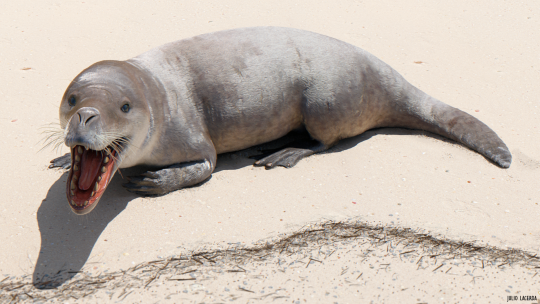
Bob the Wheal
(Rodhocetus)
Patreon • Ko-fi • Facebook • Twitter • Prints & Merch
12K notes
·
View notes
Text
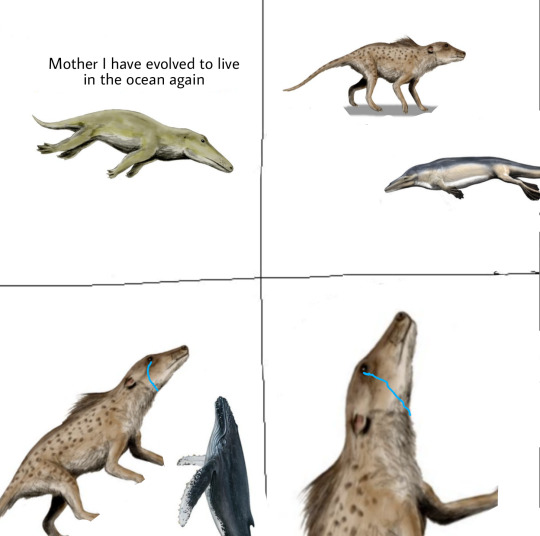
#Don't ask me why the pakicetus's feet are cropped out I don't want to talk about it#Anyways#Marine biology#Marine biology memes#The second of today lmao#paleobiology#paleoblr#pakicetus#ambulocetus#Rodhocetus#cetacean#Whale#whale evolution
278 notes
·
View notes
Photo

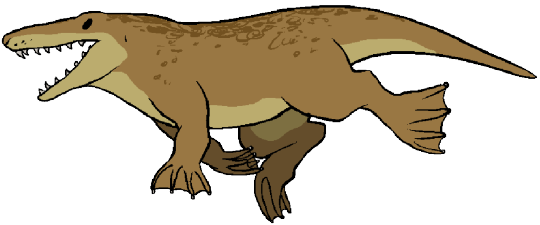

my rough illustrations of archaeoceti: pakicetus ambulocetus and dorudon
#i fixed the digits#archaeoceti#pakicetus#ambulocetus#dorudon#cetacea#notes: i know i made ambulocetus' hind limbs too large#the way i drew it is more reminiscent of protocetidae like rodhocetus#i will forgive myself because ambulocetus likely used hind limb paddling for locomotion#also im of the opintion it was already obligate aquatic#also...dorudon eyespots because why not#myart
819 notes
·
View notes
Text







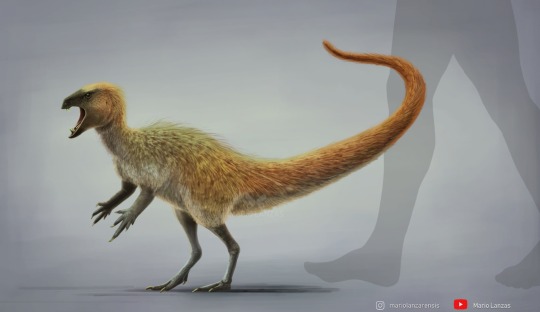

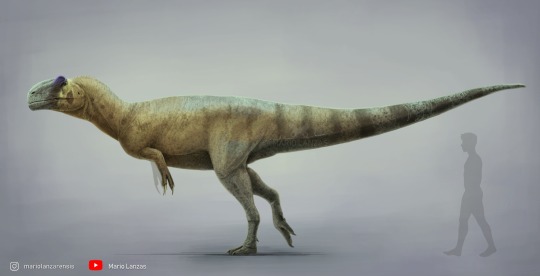



PREHISTORIC ANIMALS
Various, random reconstructions of prehistoric animals of all eras: Bison latifrons, Eotitanosuchus, Proterosuchus, Ancheornis, Rodhocetus, Silesaurus, Eryops, Heterodontosaurus, Gideonmantellia, Asfaltovenator, Juratyrant, Anomalocaris, Scutosaurus
__
Youtube channel
Instagram
Prints and more paleomerch
127 notes
·
View notes
Text
How to tell someone you know nothing about evolution without saying you know nothing about evolution (2/?)
"Whales never walked on land. It's not possible for whales to have evolved! An animal couldn't survive while having limbs that are partly for land and partly for water."
a) We know for a fact that whales used to be landbound because they have an earbone that isn't found on any other animal, meaning we can trace whale evolution by checking if that bone is present in the fossil.
This is the earliest-known animal with the bone that only cetaceans have:

b) Here's Rodhocetus, an early whale:

Its paws still looked like paws for land but would have been too weak to hold its weight out of water.
#evolution#religion#did you know#creationism#christianity#islam#cetaceans#whales#marine animals#fossils#rhodhocetus#biology#natural history#evolutionary biology#whale evolution
233 notes
·
View notes
Note
BIG fan of rodhocetus and overall the evolution of cetaceans, so I just LOVE how some folks descend from whales. It's such a cool concept on so many levels, I also wanted to say that I really enjoy seeing all of your work come to life by doing art, comics, and animations! I've been following you for a while so it's really fun to see your projects grow and develop. I think it's really remarkable and impressive!! You truly inspire me to push myself on learning how to animate, just thank you for creating so many unique concepts with your stories<3
On my hands and knees, that means the world thank you
I'm so psyched to finally get to this in a comic cause I've been rolling the re-evolved whales and little biology changes in my brain for a hot minute, case and point, some notes for you!!!

#hyped that you're starting to animate!!! I can't wait to see what u do >:')#fall warmed chilled cider
36 notes
·
View notes
Photo
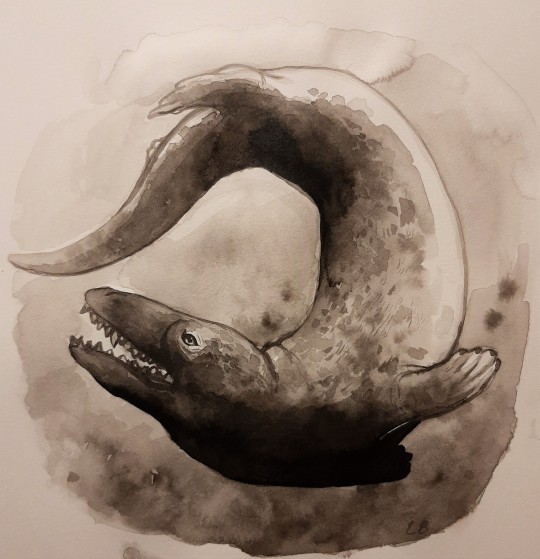
The Rodhocetus tag is basically empty for me, so I decided to speed ink one... I’m about 99% sure they weren’t this bendy but I saw this cool leopard seal photo and wanted to use it as a reference
#Eocene#Rodhocetus#palaeontology#paleontology#paleoart#palaeoart#whale#whale evolution#procetid#procetidae#forgive me if i got that wrong#lostbeasts#lost beasts#ink drawing#brush and ink#my art#my drawings
426 notes
·
View notes
Photo

Some future patch designs, hopefully.
#patch#neoproterozoic#paleozoic#mesozoic#cenozoic#rangeomorph#spriggina#dickinsonia#anomalocaris#heliocoprion#lystrosaurus#dilophosaurus#ichthyosaurus#anchiornis#elasmotherium#rodhocetus#homo sapiens#human
122 notes
·
View notes
Photo

Cetacea: Back to the Sea (Whale Evolution) by Rhizae
#indohyus#pakicetus#ambulocetus#kutchicetus#rodhocetus#protocetus#durodon#basilosaurus#aetiocetus#mammalodon#cetotherium#balaenoptera#whale#cetacean#evolution#paleoart#art
3 notes
·
View notes
Text
And Now For Something Completely Different... The Opening of the Darwin Dohrn Museum. Prehistoric Marine Life Murals in Naples!
And Now For Something Completely Different… The Opening of the Darwin Dohrn Museum. Prehistoric Marine Life Murals in Naples!
A brief summary of whale evolution for starters… Including Pakicetus, Ambulocetus, Maiacetus, Rodhocetus, Dorudon, and Basilosauarus (with guests: non-prehistoric Orcas)
And then, the apotheosis…
And then… the corridor… “slab and counter slab”.
It is not very often I have been asked to get into restoring marine life evolution… but my friend Marco Signore asked me to do this mammoth task. I…

View On WordPress
#Ambulocetus#Basilosaurus.#Burgess Shale Fauna#Darwin Dohrn Museum#Dorudon#Ediacara#Leedsichthys#Maiacetus#Marco Signore#Marine Evolution#Megalodon#Murals#Naples.#Pakicetus#Rodhocetus
0 notes
Photo

https://commons.wikimedia.org/wiki/File:Rodhocetus.jpg
1 note
·
View note
Text
Tutti sappiamo che balene e delfini sono mammiferi...
...ed è anche risaputo che si sono evoluti a partire da animali terrestri, per poi riadattarsi alla vita acquatica. Dico riaddattarsi perché chiaramente tutti noi mammiferi abbiamo come antenati i pesci ossei. Quindi in un certo senso i cetacei sono pesci mutanti che sono tornati negli oceani.
Ma da quali dei vari ordini di mammiferi si sono evoluti balene e delfini? Grazie alle moderne tecniche di biologia molecolare, in particolare comparando i codici genetici, è stato possibile negli ultimi anni determinare che i parenti più prossimi dei cetacei sono gli artiodattili, ovvero ungulati con un numero pari di dita, cioè ippopotami, maiali, cammelli, giraffe, cervi, antilopi, bovini, pecore, capre... Tanto prossimi che l'antenato comune è esistito circa 64 milioni di anni fa, mentre la famiglia degli ippopotami si è separata da quella dei cetacei circa 53-54 milioni di anni fa. Recenti studi hanno indotto gli scienziati a istituire un unico ordine chiamato Cetartiodactyla (dall'unione di Cetacea e Artiodactyla). Di seguito un albero filogenetico che mostra le famiglie e come sono imparentate:

Per quanto riguarda l'evoluzione, si è scoperto in Pakistan il primo ungulato classificabile come cetaceo: l'estinto Pakicetus inachus, animali terrestri delle dimensioni di un lupo, che vissero circa 53 milioni di anni fa.

Già 48 milioni di anni fa viveva invece l'Indohyus major: delle dimensioni di un procione ma molto più pesante, già adattato alla vita semiacquatica.
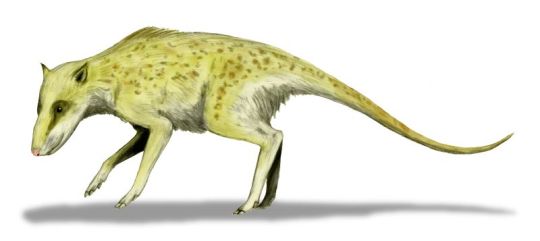
Ambulocetus natans, ritrovato in uno strato di sedimenti risalente a 48-47 milioni di anni fa, era sicuramente anfibio e lungo 3 metri. Aveva già zampe adattate al nuoto ed una coda che usava per nuotare muovendola verticalmente, come tutti cetacei moderni:
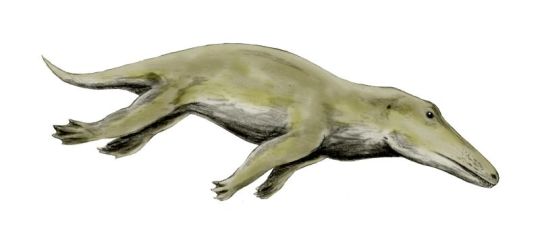
Sempre attorno ai 47 milioni di anni fa, vissero i rodontoceti, Rodhocetus kasrani e R. balochistanensis:
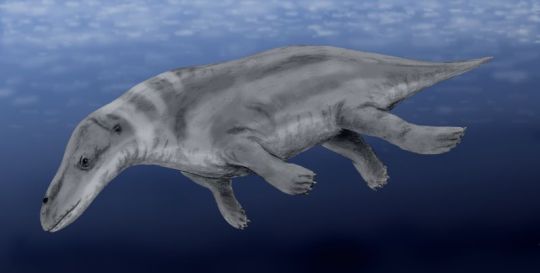
Anche loro erano anfibi, e avevano grandi zampe che potevano supportare il peso anche fuori dall'acqua. Alcune ricostruzioni gli attribuiscono già una pinna caudale, ma non è chiaro se ce l'avesse.
38 milioni di anni fa, invece, vissero i basilosauridi e durontidi, cetacei che ormai vivevano interamente in mare. I basilosauridi, quando furono scoperti, furono scambiati per rettili, da cui il nome traducibile con lucertola imperatore. Il Basilosaurus cetoides poteva essere lungo dai 15 ai 18 metri, ma nonostante le dimensioni simili a quelle di una balena la sua alimentazione era diversa: mangiava altri cetacei, pesci ossei, pesci cartilaginei (quindi anche squali), granchi e calamari:
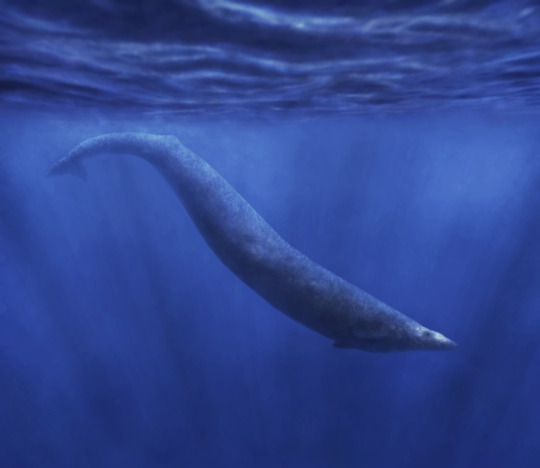
Il Dorudon atrox, lungo 5 metri, poteva essere una delle prede abituali del Basilosaurus, ma era anch'esso un predatore di pesci e molluschi:

Fra i 33 e i 14 milioni di anni fa visse lo Squalodon calvertensis. Il primo cetaceo con un organo per l'ecolocalizzazione, era lungo 3 metri e possedeva un corpo simile alle focene. Anche questo fu scambiato inizialmente per un rettile, in particolare per un genere simile a quello dei dinosauri iguanodonti.
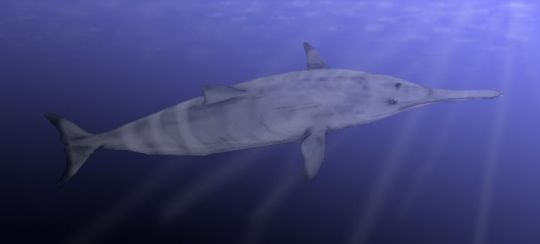
Oggi dividiamo i cetacei in Misticeti (con mascelle provviste di fanoni, cioè le balene) e gli Odontoceti (provvisti di denti, ad esempio i delfini).
Delle prime balene, vissute fra i 39 e i 29 milioni di anni fa, si hanno i pochi resti fossili del Llanocetus denticrenatus: frammenti di cranio e di una grande mandibola dai quali è stato possibile calcolare che il solo cranio fosse lungo 2 metri. Nonostante fosse privo di fanoni, gli studiosi ipotizzano che filtrasse il cibo in maniera analoga:

Un antenato degli odontoceti era invce il Kentriodon pernix, una specie di delfino primitivo vissuto circa 12 milioni di anni fa, lungo circa 2 metri, cacciatore di piccoli pesci:
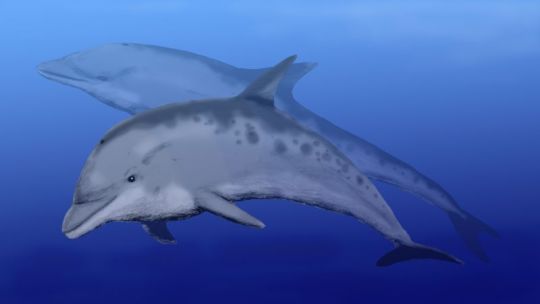
Sono stati ritrovati fossili di cetacei estinti ancora più simili a quelli attuali ma la trasformazione evidenziata da queste ricostruzioni paleoartistiche è chiara
Un particolare interessante che si nota riguardano le ricostruzioni è la scomparsa delle zampe posteriori, che però non scomparvero veramente: in realtà esistono ancora, invisibili, come loro vestigia all'interno del corpo, collegate alle ossa pelviche ma non alla colonna vertebrale. Hanno perso quindi completamente la loro funzione motoria se non per l'inserzione dei muscoli dei genitali. Altro particolare visibile nella sequenza delle illustrazioni è la migrazione delle narici che si sono trasformate in sfiatatoi.
Fonti: Wikipedia, TimeTree, Nobu Tamura paleoart, Encyclopaedia Britannica.
8 notes
·
View notes
Text




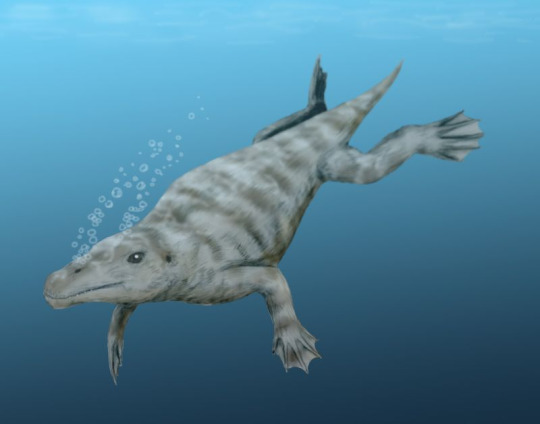


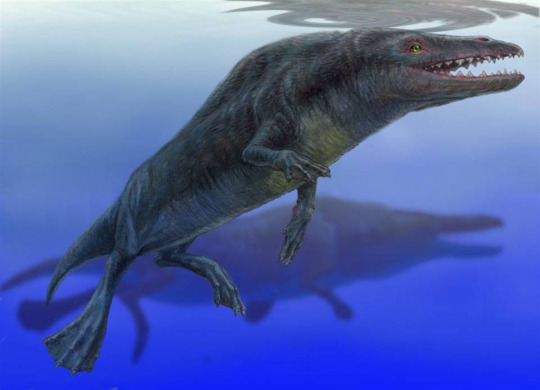
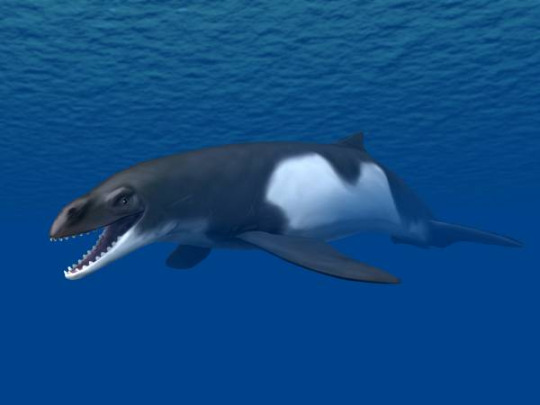
Paleoart of ancient cetaceans that I like but that also makes me uncomfortable!
(Rhodocetus kasrani / Ambulocetus / Basilosaurus cetoides / Ocucajea (top), S. muizoni (bottom) / Georgiacetus vogtlensis / Aegyptocetus / Peregocetus / Rodhocetus / Janjucetus)
1 note
·
View note
Text
you cant exactly google this stuff. so after like 6 hours of sifting through academic papers ranging from 1994 to 2017 i can conclude that we still have no conclusive evidence where the ability to walk cut off for archaeocetes. one paper proposes it was as early as ambulocetus but another implies rodhocetus (a goddamn protocetid) could still walk on land, albeit poorly. and now im getting a headache realizing the archaeocete geological timeline looks like this
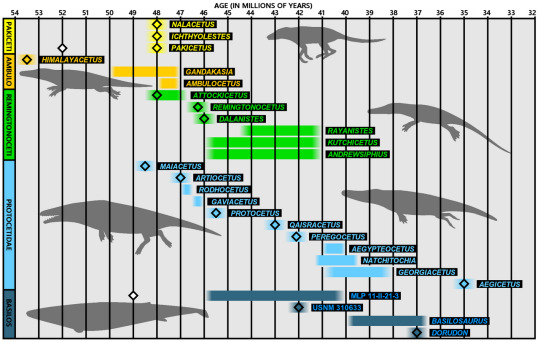
(via the amazing sneaking stoat 2 on wikipedia with beautiful citations)
#himalayacetus is rocking my world. what do you mean ambulocetidae predates pakicetidae WHAT ARE YOU TALKING ABOUT#cetacea
14 notes
·
View notes
Link
An ancient four-legged whale walked across land on hooved toes and swam in the sea like an otter.
The newly discovered species turned up in 2011 in a cache of fossilized bones in Playa Media Luna, a dry coastal area of Peru. Jawbones and teeth pegged it as an ancient cetacean, a member of the whale family. And more bones followed.
“We were definitely surprised to find this type of whale in these layers, but the best surprise was its degree of completeness,” says Olivier Lambert, a paleontologist at the Royal Belgian Institute of Natural Sciences in Brussels.
Jaw, tooth and spine features, described April 4 in Current Biology, don’t quite match anything else in the fossil record, setting the skeleton apart as a new species, dubbed Peregocetus pacificus (meaning “the traveling whale that reached the Pacific Ocean”). At 42.6 million years old, it’s the oldest whale skeleton found in the New World, though some fossilized whale teeth from North America may be even older.
Big, possibly webbed feet and long toes would have allowed P. pacificus to dog-paddle or swim freestyle. And like modern otters and beavers, this whale’s vertebrae suggest that its tail also functioned as a paddle. With tiny hooves and strong legs and hips, the animal could walk on land. But “it was definitely a better swimmer than walker,” Lambert says.
Whales got their start on land and gradually adapted to a water-dwelling lifestyle. The first amphibious whales emerged more than 50 million years ago near what’s now India and Pakistan. The new species shares some similar features with Maiacetus and Rodhocetus, two early whales from that area. P. pacificus’ age supports the idea that whales migrated across the South Atlantic and around South America to the Pacific Ocean in their first 10 million years of existence.
18 notes
·
View notes
Text
Transitional Fossil Time!
Rodhocetus
Lived circa 45 million years ago.
Discovered: 1994
Location: Pakistan
Transitional form of: Whales becoming waterbound.

We have two partial skeletons which together give us a full picture of this early whale.
As you can see in the above representation by Pavel Riha, its limbs were shortening but its toes were very long, indicating they were probably webbed and paddle-like. The overall look of their limbs is already remarkably similar to that of modern whales’ fins:

But the real key feature of their transitional state I wanna bring to your attention though, is... their nostrils.
Most animals with a muzzle have their nostrils at the front of their muzzle.
The ones that don’t tend to be water-dwellers like crocs, who tend to have their nostrils slightly further up the muzzle so they don’t have to stick their whole head out of the water to breathe to avoid giving away their location.

That nostril further up Rodhocetus’ muzzle was because it was in the process of migrating up to the forehead to become what we now know as blowholes.
31 notes
·
View notes